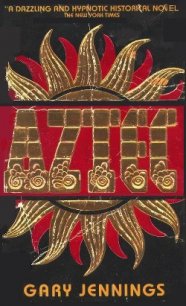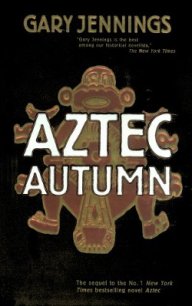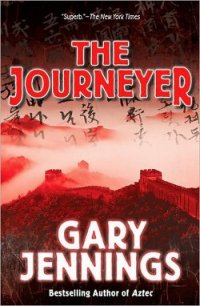Aztec Blood - Jennings Gary (книги онлайн бесплатно серия .txt) 📗
Today Spain is the greatest military power in the world, dominating not just the European continent, but ruling an empire that it is truly said the sun never sets upon. Christopher Columbus had laid the seeds of the empire by running into a whole new continent on his way to that vast land in Asia called India. But Columbus and the generation that followed were mostly concerned with Caribbean islands. Although they knew there was a great land mass to the west beyond the islands, little of it had been explored several decades after the 1492 discovery.
One of the men who followed in the wake of Columbus had been sent off to study law at a university but set aside his pen to take up the sword.
Hernando Cortes was born in Medellin, in the province of Estremadura, Spain, in 1485, seven years before Columbus sailed to the New World. He grew up in an almost fever-pitched atmosphere of tales of glory and adventure as more and more stories of riches and conquest came back from the early explorers. In truth, the Caribbean islands, which were the first conquests, were actually poor in everything but indios, whom the conquerors could use as slave labor.
Even though the New World had not yet fulfilled its promise of lands paved with gold, Cortes and his compatriots still dreamed of faraway places to be conquered. The fray said they had read too many "chivalric romances" in which a knight-errant found love, treasure, and glory. The most famous of these books I have mentioned before: Amadis of Gaul. Amadis was a prince cast out to sea on an ark at birth because his mother couldn't reveal who his father was. The prince grows up, falls in love with a princess, and has to go out into the world as a wandering knight and win her hand. He fights monsters, visits enchanted islands, and returns to his love.
To young men like Cortes, Amadis was not just a story, but a sign to seek to their God-given chance at "love, treasure, and glory" in the New World across the sea.
At the age of seventeen, Cortes left university and managed to get the promise of a berth aboard a ship bound for the New World, but fate—and his young man's lust—dealt him a bad hand. Scaling a stone wall to gain access to the apartment of a woman with whom he was engaged in an intrigue, the wall gave way and he fell, almost buried by the rubble.
Too injured to cross an ocean, two more years passed, and he was nineteen when he next got the opportunity. When he arrived at Hispaniola, the Caribbean island that was the main seat of Spanish rule, he went to see the governor and was told, because of family connections, that he would get a grant of land and a repartimiento of indios for slave labor. His reply to the governor's secretary was that he had not come to the New World to farm. "I came for glory and gold, not to till the soil like a peasant."
Mateo told me that this man of destiny, Hernando Cortes, was of medium height, slender, yet had a surprisingly deep chest and broad shoulders. His eyes, hair, and short beard were dark as any Spaniard's, yet his complexion was unexpectedly pale.
At first, he found no opportunity for conquering new worlds. While a number of Caribbean islands had been discovered, and the Crown was aware of a great, mysterious land mass beyond, no one realized that great empires already existed in what were to become New Spain and Peru.
Cortes impatiently worked his land and indios, but his hot-bloodied temperament kept him in trouble, mostly of a feminine nature. Amorous affairs turned into affairs of honor played out with swords, and he carried these scars to the grave.
During this time he obtained experience fighting against indios, putting down insurrections, and serving in the conquest of Cuba. Despite his good military record, he became embroiled in controversy with the new governor of Cuba, Velasquez, after a romantic entanglement with a daughter of the powerful Xuarez family. When Cortes refused to consummate the affair by marrying the girl, Governor Valasquez had him arrested and put into iron shackles. Cortes managed to work himself free of the fetters, pried apart iron bars, and leaped from his prison window. At a nearby church, he called upon the sanctuary of the Church—the civil authority could not arrest him while he was in God's house.
The governor placed guards near the church waiting for Cortes to make a move. When the young man got careless and wandered a few feet from the church grounds, one of the governor's men jumped him from behind and pinned his arms until other guards joined the fracas.
Put into irons again, he was put aboard a ship bound for Hispaniola, where he was to be tried for his defiance. He managed to get out of the shackles again, this time stealing a small boat being towed behind the ship, and made his way back to shore, abandoning the rowboat and swimming ashore when the small boat became unmanageable. He made his way back again to the sanctuary of the church.
Rather than maintaining a dispute he could not hope to win, he agreed to marry the wronged young woman, Catalina Xuarez, and reconciled with Governor Velasquez. Following his marriage, Cortes settled down to farm his land with several thousand repartimiento indios he had been granted. By this time he had a slash on his face from a duel over a woman.
He was thirty-three years old and a prosperous landowner when news came that an expedition had made contact with an indio culture along the Caribbean coast of what was to become New Spain. The news sent shock waves through the Spanish—another land to explore and plunder! An expedition was organized by Velasquez to explore the area and Cortes was granted his plea to lead it. Despite their past problems, Velasquez recognized in Cortes a bold, aspiring spirit who craved gold and glory.
Cortes immediately set out to put together the expedition, getting the men, supplies, and ships necessary, selling or borrowing off everything he owned to cover much of the cost. Velasquez, seeing the lengths of Cortes's efforts, realized that the man was likely not only to succeed but to claim all glory for himself. Jealous, he was about to revoke Cortes's authority when Cortes surprised him by setting sail without completing the preparations. Velasquez's orders to stop and arrest Cortes chased the adventurer as he went from port to port to gather men and supplies. Often he had to use his cannons to persuade the local authorities to ignore the governor's orders.
He finally set out for the area to be explored, landing on the west coast of New Spain with 553 soldiers, fourteen cannons, and sixteen horses. He told his men that they were setting out on a noble venture that would make them famous throughout the ages, that he was leading them to a land richer than any found before.
"Great things are achieved only by great exertion," he told them. "Glory was never the reward of the sloth!"
On April 21, 1519, Cortes landed at the place he called La Villa Rica de la Veracruz, the Rich Town of the True Cross. He came for glory, gold, and God.
Wrapped up in the religious zeal was the conception by the Spaniards that the indios were guilty of every kind of vice. But the most heinous crimes committed by the indios in the eyes of the Spanish were not on the battlefield or the sacrificial block but in bed. The Spaniards continuously charged them with the crime against nature, the crime that dare not speak its name: sodomy.
Despite the view of the Spanish, the practice of sodomy was not universal. The Aztecs punished sodomy harshly. The indio acting as a female had his virile parts cut off and a hole cut between his legs. Then his entrails were removed through the hole. I shuddered at the thought of someone taking a knife, spreading my legs, cutting out a hole, and sticking their hand up the hole to remove my guts.




